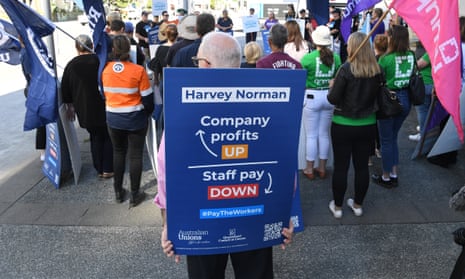The retail giant Harvey Norman has deleted its Twitter account after mass blockings of critics and bizarre emoji responses to those who challenged the company over the action.
Harvey Norman has come under sustained criticism over its founder Gerry Harvey’s refusal to pay back $22m in jobkeeper payments, despite the company doubling its profit in the second half of last year to $462m.
Last week, the Australian Council of Trade Unions stepped up its campaign over Harvey Norman’s refusal to pay back the money, as part of the ACTU’s push for the minimum wage to be raised by 3.5%.
In addition to protests outside stores, the ACTU ran an online campaign calling for people to boycott Harvey Norman in several states across Australia.
At the weekend, although the company’s Twitter account said it was not staffed, it began blocking and responding to users who had joined in on the campaign.
The ACTU’s own account as well as the account of its secretary, Sally McManus, were blocked. The Victorian minister Martin Pakula and the federal Greens leader, Adam Bandt, were also included in the blockings. Pakula said he had had no interaction with the account before it blocked him.
When one user, @sisyphysical, said working for the company “drove me to suicide in 6 months” the company replied late in the evening with face palm and hand-waving emojis.
The account also tweeted a kissing emoji in response to another tweet critical of the mass blockings.
By Tuesday morning, after strong public backlash over the account’s unusual responses to criticism, it appeared to be deleted.
Guardian Australia has sought comment from Harvey Norman.
Dr Emily van der Nagel, a researcher in social media platforms at Monash University, said the whole saga showed up several failings in Harvey Norman’s social media presence, including how it had responded to potential customers and the public.
“It has brought together a number of things you really shouldn’t do, when you’re trying to manage a social media account like this, including not taking appropriate kind of PR steps during a brand crisis, by any measure,” she said.
Van der Nagel said paying the jobkeeper back or giving employees more pay would have been a better PR move “than having a weird Twitter account that has gone the full sarcastic approach to someone experiencing a really, really intense mental health crisis”.
The account needed to have a consistent approach that appropriately engaged with tweets, she said, alongside an understanding of how Twitter works.
“I feel like if they tap in to Twitter’s origins as a kind of playful, mundane, chatty space, and they get a customer representative in there, who has a brand-focused, engaging, friendly voice, then it can be a real touch point for people. And a lot of brands aren’t doing that well.”
